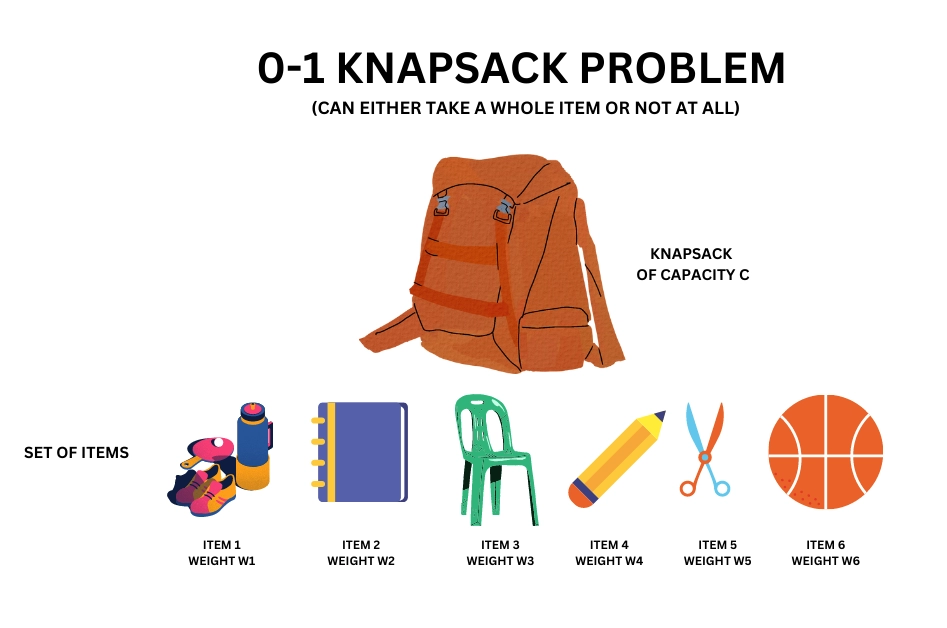Optimization lies at the heart of every decision—whether it’s choosing what to pack for a trip, allocating a marketing budget, or determining which products deserve space on a store shelf. Behind all these decisions is a deceptively simple yet immensely powerful concept: the Knapsack Problem.
What began as a mathematical puzzle has evolved into a cornerstone of modern analytics, artificial intelligence, and business optimization. Companies like Cresco International are using it to deliver measurable results, operational excellence, and real-world ROI.
1. WHAT EXACTLY IS THE KNAPSACK PROBLEM?
Imagine you have a backpack with limited capacity and several items, each having a value and a weight. The goal is to fill the bag in such a way that the total value of selected items is maximized without exceeding the capacity.
In simple terms:
Maximize Value (Profit) under a Constraint (Capacity).
This challenge may look easy for a few items but grows exponentially complex as variables increase—making it a perfect example of a computationally hard problem. It’s formally represented as:
Maximize: Σ (value[i] × x[i])
Subject to: Σ (weight[i] × x[i]) ≤ Capacity
where x[i] ∈ {0,1}
Variants of the Knapsack Problem:
- 0/1 Knapsack: Each item can either be taken or left.
- Fractional Knapsack: Items can be divided (useful in budget allocations).
- Unbounded Knapsack: You can take multiple copies of the same item.
- Bounded Knapsack: Each item has a limit on quantity.
Each variant reflects different real-world decision scenarios in business, logistics, and finance.
2. WHY BUSINESSES SHOULD CARE
At its core, every business faces a resource allocation challenge. Budgets, inventory, production time, or personnel—everything has limits. The Knapsack framework provides a structured way to choose the most valuable combination of decisions under these limits.
Real-World Applications:
- Retail & Supply Chain: Choosing the most profitable product mix for limited shelf or vehicle space.
- Finance: Allocating limited investment capital across competing opportunities.
- Marketing: Distributing a fixed advertising budget for maximum reach.
- Manufacturing: Selecting production batches under material or labor constraints.
- Workforce Management: Assigning employees optimally to maximize output.
Cresco International helps organizations convert these challenges into formal optimization problems using AI-driven decision modeling, creating systems that make data-backed, optimal decisions consistently.

3. COMPLEXITY — WHY IT’S HARD (AND FUN)
The 0/1 Knapsack Problem is NP-hard, meaning as input size grows, solving it perfectly becomes computationally intensive. Yet, many near-optimal and exact approaches exist.
Solution Strategies:
- Greedy Algorithm: Works best for Fractional Knapsack—quick and efficient.
- Dynamic Programming (DP): Guarantees an exact solution by building solutions incrementally (commonly used for 0/1 Knapsack).
- Branch and Bound / MILP: Used for large-scale enterprise-grade problems.
- Metaheuristics: Genetic Algorithms, Ant Colony Optimization, and Simulated Annealing offer fast approximations when the problem scales massively.
Cresco leverages these methods within enterprise optimization frameworks powered by IBM CPLEX, Gurobi, and FICO Xpress.
4. HOW TO SOLVE IT — STEP-BY-STEP
Fractional Knapsack:
- Sort all items by value-to-weight ratio (value ÷ weight).
- Pick items starting from the highest ratio until capacity is full.
- If an item doesn’t fit completely, take the fraction that does.
Time Complexity: O(n log n)
0/1 Knapsack (Dynamic Programming):
- Create a DP table where rows represent items and columns represent capacities.
- For each item and capacity, choose the better of:
- Including the item, or
- Excluding the item.
- The final cell gives the maximum achievable value.
Time Complexity: O(n × W), where W is the capacity.
In business terms, this method determines which combination of investments, products, or actions yields the highest return under given constraints.
5. WHEN MATH MEETS BUSINESS — THE CRESCO ADVANTAGE
Cresco International doesn’t just “solve” the knapsack—it operationalizes it. By combining mathematical rigor with business understanding, Cresco converts theoretical optimization into real-time decision systems.
They employ:
- IBM Decision Optimization (CPLEX) for mathematical precision.
- AI-powered data modeling to identify hidden constraints.
- Cloud-based APIs for integrating optimization with ERP, CRM, or BI systems.
- Governance dashboards for ongoing monitoring, adjustment, and ROI tracking.
This transforms optimization from a one-time analysis into a continuous, AI-enhanced process.

6. REAL-WORLD EXAMPLE — INVENTORY OPTIMIZATION
A global retailer needed to select 100 SKUs for limited shelf space across 1,000 stores. Each item had:
- Profit margin
- Shelf-space requirement
- Regional preference
- Supply constraints
Cresco International modelled this as a 0/1 Knapsack Problem with multi-constraint optimization, solved it via IBM CPLEX, and integrated results into the retailer’s ERP system.
Outcome:
- +12% increase in profit margins
- -18% reduction in overstock waste
- +25% faster decision turnaround
This example showcases how Cresco’s optimization approach converts mathematical logic into tangible business outcomes.
7. ADVANCED OPTIMIZATION TECHNIQUES
For large-scale enterprise challenges, Cresco employs:
- Mixed Integer Linear Programming (MILP) – for precise optimization.
- Branch & Bound / Cutting Plane – to prune and accelerate solution discovery.
- Metaheuristics (Genetic, Swarm, Annealing) – for real-time approximations.
- FPTAS (Fully Polynomial-Time Approximation Schemes) – for nearly exact large-scale solutions.
These techniques are selected based on business priorities—speed, scalability, or accuracy.
8. THE ARCHITECTURE BEHIND A BUSINESS KNAPSACK SOLUTION
Cresco’s solution framework typically includes:
- Modeling Layer: Defines goals, variables, and constraints using mathematical logic.
- Solver Layer: Executes optimization via CPLEX, Gurobi, or open-source alternatives.
- Integration Layer: Connects optimization outputs to operational systems (SAP, Salesforce, Power BI, etc.) via APIs.
- Governance Layer: Tracks KPIs, ROI, and continuously improves models based on real-time feedback.
This architecture ensures that optimization remains sustainable, scalable, and auditable.

9. HOW CRESCO HELPS YOU SOLVE IT — STEP-BY-STEP
- Discovery: Understand your business goals and resource constraints.
- Modeling: Translate business logic into mathematical equations.
- Simulation: Run optimization models in Cresco’s AI Sandbox.
- Deployment: Integrate solutions into your enterprise workflow or cloud.
- Monitoring: Track KPIs and refine the model as data evolves.
Explore more at:
- AI Advisory Services: https://crescointl.com/ai-advisory-service/
- Decision Optimization: https://crescointl.com/decision-optimization/
- Cloud & Infrastructure: https://crescointl.com/cloud-infrastructure/
- Industries Served: https://crescointl.com/industries/
10. A SIMPLE ROADMAP TO GET STARTED
- Define your objective clearly.
- Gather and clean relevant data.
- Choose an algorithm based on problem type and complexity.
- Prototype using small datasets.
- Validate business relevance with domain experts.
- Scale using Cresco’s enterprise infrastructure.
- Track ROI and continuously optimize.
11. WHY IT’S CALLED THE “KNAPSACK PROBLEM”
The term “Knapsack” originates from knappsack—a German soldier’s food bag. The name reflects the idea of maximizing value under limited capacity, symbolizing efficient resource management—a principle that now drives business decision optimization globally.
12. FINAL TAKEAWAY
The Knapsack Problem represents a universal truth: resources are limited, but possibilities are infinite. By using mathematical modeling, AI, and advanced optimization, businesses can systematically identify which decisions deliver the highest impact.
With Cresco International, the Knapsack Problem becomes not just a theoretical puzzle—but a powerful decision engine that maximizes profit, minimizes waste, and drives sustained competitive advantage.
READY TO OPTIMIZE?
Whether it’s optimizing your product portfolio, resource allocation, logistics, or workforce, Cresco International can help you implement scalable, AI-driven optimization models tailored to your needs.
Schedule a consultation today: https://crescointl.com/our-story/general-contact/









